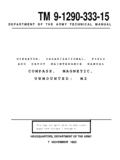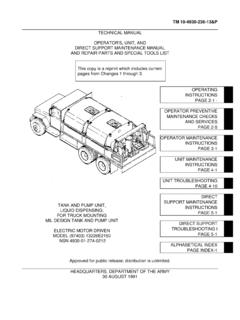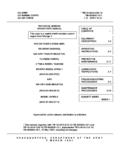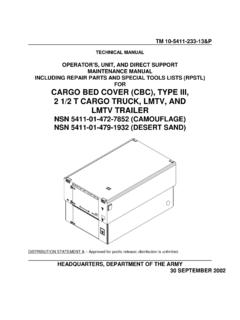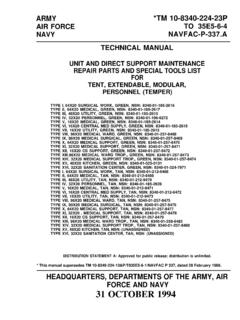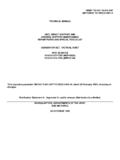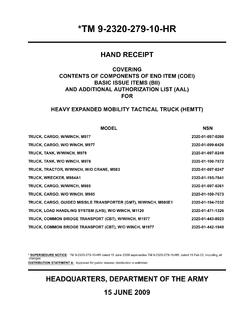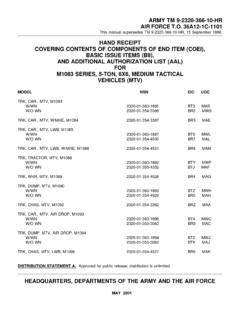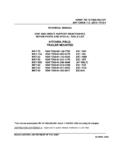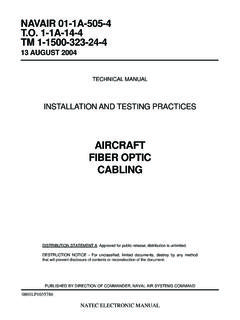Transcription of Automated Net Control Device (ANCD ... - …
1 COMBAT NET RADIOTM 11- 5820 -890-10-6 TECHNICAL MANUAL SSIINNCCGGAARRSS GGRROOUUNNDD IICCOOMM RRAADDIIOOSS Used with Automated Net Control Device ( ancd ) AN/CYZ-10; Precision Lightweight GPS Receiver (PLGR) AN/PSN-11; Handheld Remote Control Radio Device (HRCRD) C-12493/U; Simple Key Loader (SKL) AN/PYQ-10 OOPPEERRAATTOORR''SS PPOOCCKKEETT GGUUIIDDEE MANPACK RADIOS AN/PRC-119A/D/F (NSN: N/A)(EIC: N/A) VEHICULAR RADIOS AN/VRC-87A/D/F thru AN/VRC-92A/D/F (NSN: N/A)(EIC: N/A) Approved for public release; distribution is unlimited. HEADQUARTERS, DEPARTMENT OF THE ARMY 1 JULY 2007 a b WARNING RECHARGEABLE BATTERIES This includes BB-390/U Nickel-Metal Hydride (Ni-MH) and BB-2590/U Lithium-Ion (Li-ion). Do not leave batteries in equipment for long term storage (more than 30 days).
2 Charge batteries in long term storage at least annually, and charge them before inserting in equipment. Before opening original packaging always examine the package for signs of leakage, staining or other indications of battery damage. DO NOT use a damaged battery. Always charge a rechargeable battery on the appropriate charger according to the dictates of the manufacturer. NEVER disassemble, heat, burn, or incinerate these or any batteries. CO2 or Dry Chemical fire extinguishers are suggested for fires involving these batteries. Turn in batteries for disposal. Dispose of them in accordance with local regulations. WARNING NON-RECHARGEABLE ZINC-AIR BATTERIES This includes BA-8180/U Zinc-Air (Zn-Air). Do not leave batteries in equipment for long term storage (more than 30 days).
3 Before opening original packaging always examine the package for signs of leakage, staining or other indications of battery damage. DO NOT use a damaged battery. Zn-Air batteries contain gelled Potassium Hydroxide (KOH) as an electrolyte. This is corrosive and will burn the skin. If it comes in contact with the skin, wash thoroughly with soap and water. If it comes in contact with the eyes, flush with copious amounts of water and seek immediate medical attention. NEVER disassemble, heat, burn, or incinerate these or any batteries. CO2 or Dry Chemical fire extinguishers are suggested for fires involving these batteries. Turn in batteries for disposal. Dispose of them in accordance with local regulations. c WARNING LITHIUM NON-RECHARGEABLE BATTERIES Lithium Non-Rechargeable Batteries contain a great deal of energy.
4 They must never be charged or abused. Attempting to do so could result in leakage, fire or even an explosion. Lithium-Sulfur Dioxide (Li-SO2) batteries, such as BA-5590, contain a toxic, pressurized, and liquefied gas. It has a strong pungent odor. Lithium-Manganese Dioxide (Li-MnO2) batteries such as BA-5372 (Hold Up Battery) and BA-5390 contain a flammable electrolyte. Both types of batteries contain pure Lithium which reacts violently with water. DO NOT heat, incinerate, short circuit, puncture, mutilate or attempt to disassemble any battery. DO NOT USE any battery which shows signs of damage, such as bulging, swelling, disfigurement, leaking or staining inside the plastic packaging. Keep all batteries in their original packaging until ready for use.
5 DO NOT test Lithium batteries for capacity with a test set. No external test set exists that provides a reliable result. DO NOT store batteries in unused equipment for more than 30 days. If a battery compartment becomes hot to the touch, if it hisses or makes a burping sound, or if you smell an irritating gas: TURN OFF the equipment immediately and clear the area if you smell the pungent Sulfur Dioxide. Let the equipment cool for at least an hour. After the equipment is cool and the odor has cleared, remove the battery or batteries. Install new battery or batteries and resume operation. If the equipment again becomes hot to the touch, go through the above steps but do not install new batteries. DO NOT place Lithium batteries in ordinary trash; turn them in for disposal in accordance with local regulations.
6 DO NOT store Lithium batteries with other hazardous materials and keep them away from open flame or heat. DO NOT use water to fight a Lithium battery fire. This is an extremely intense fire frequently characterized by a bright red flame. Carbon Dioxide or dry chemical fire extinguishers are effective in fighting fires d of other combustibles and in keeping the batteries cool when exposed to fires in the vicinity. Sprinklers are recommended for storage areas to douse fires of other combustible materials and to keep batteries cool. NEVER use a Halon type fire extinguisher on a Lithium battery fire. This will only increase the intensity of the fire. In the event of a Lithium fire, immediately EVACUATE THE AREA and contact the appropriate emergency authorities.
7 Class D fire extinguishers are to be used only by professional fire fighters. If you experience a safety hazard or incident, notify your unit Safety Officer; file a SF 368 (Product Quality Deficiency Report); and notify the CE-LCMC Safety Office, Ft. Monmouth, NJ, DSN 987-7445 or commercial (732) 427-7445. MANPACK LONG ANTENNA SAFETY PRECAUTIONS WARNING DEATH OR SERIOUS INJURY CAN OCCUR IF THE ANTENNA COMES INTO CONTACT WITH OVERHEAD POWER LINES Never fully extend the long antenna directly under power lines. If you must fully extend the long antenna near power lines, power line poles or towers, or buildings with overhead power line connections, never come closer than two times the antenna height from the base of the power line, pole tower, or building.
8 Stop before you get close to the power line and check for clearance before passing. If needed, either tie down the antenna or remove the antenna to make sure that you can safely pass under the power line. When mission permits, use the short antenna during operations on the move. If you must use the long antenna on the move, never pass under power lines if there is any doubt about overhead clearance. For additional safety information, refer to TB 43-0129, Safety Requirements for Use of Antenna and Mast Equipment. e/f blank VEHICULAR ANTENNA SAFETY PRECAUTIONS CAUTION TURN RADIO OFF WHEN NOT IN USE. Turn Loudspeaker LS-671 power switch OFF when radio is not in use to prevent drain on vehicle batteries. WARNING DEATH OR SERIOUS INJURY CAN OCCUR IF THE ANTENNA COMES INTO CONTACT WITH OVERHEAD POWER LINES Do not stop your vehicle under power lines.
9 When mobile, never pass under power lines if there is any doubt about overhead clearance. If you are not sure that an antenna on your vehicle will clear a power line, stop before you get close to the power line and either tie down the antenna or, if necessary, remove the antenna to make sure that you can safely drive under the power line. During cross-country operations, do not allow anyone to stick an arm, leg, or weapon over the sides of the vehicle. If your antenna accidentally touches a power line, individuals who are in contact with vegetation or the ground could suffer death or severe injury. For additional safety information, refer to TB 43-0129, Safety Requirements for Use of Antenna and Mast Equipment. CAUTION SINCGARS HUB and ancd batteries look similar and can be physically interchanged.
10 The HUB battery is Volts, while ancd batteries are 3 Volts each. If three HUB batteries are mistakenly placed in an ancd , the ancd will be destroyed. Placing one ancd battery in the SIP radio HUB position will cause the RT to lose its fill of data. Be sure you know which battery you are installing. Always read the label before installing either HUB or ancd batteries! i * tm 11 - 5820 -890-10-6 Technical Manual HEADQUARTERS DEPARTMENT OF THE ARMY No. 11- 5820 -890-10-6 WASHINGTON, , 1 JULY 2007 TECHNICAL MANUAL SSIINNCCGGAARRSS GGRROOUUNNDD IICCOOMM RRAADDIIOOSS Used with Automated Net Control Device ( ancd ) AN/CYZ-10; Precision Lightweight GPS Receiver (PLGR) AN/PSN-11; Handheld Remote Control Radio Device (HRCRD) C-12493/U; Simple Key Loader (SKL) AN/PYQ-10 OOPPEERRAATTOORR SS PPOOCCKKEETT GGUUIIDDEE MANPACK RADIOS AN/PRC-119A/D/F (NSN: N/A) (EIC: N/A) VEHICULAR RADIOS AN/VRC-87A/D/F thru AN/VRC-92A/D/F) (NSN: N/A) (EIC: N/A) *This manual supersedes tm 11 - 5820 -890-10-6, dated 1 December 1998.
